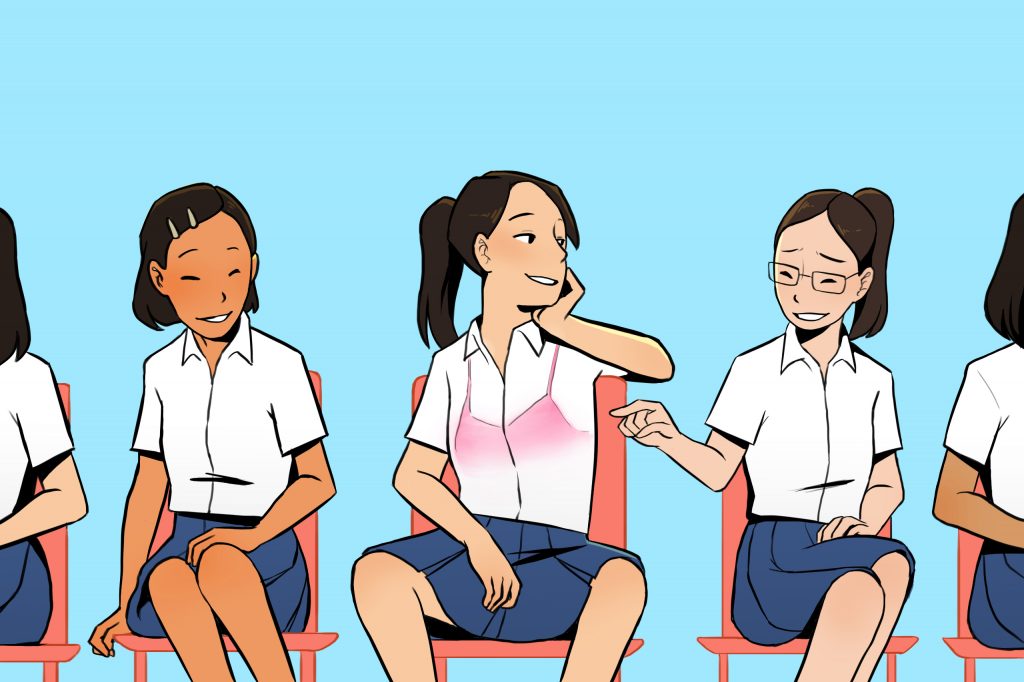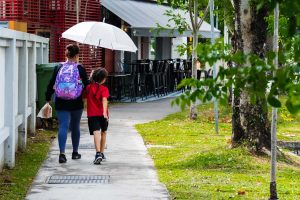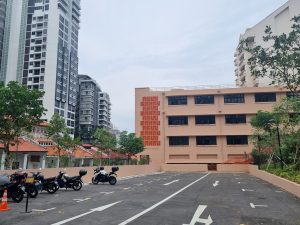Top image: Kimberly Teo from A Good Citizen
In 2019, the Straits Times wrote about a teacher pulling out her students’ bra straps during a “bra colour” inspection, leading students and parents to file complaints. In Singapore, it is not uncommon for secondary schools to police girls into wearing white or nude coloured bras instead of black or coloured ones.
Reading this, I was brought back to my days in secondary school as a 13-year-old. I remember standing in a row with other girls in the school hall, berated for wearing a black bra. I remember once we were about to be sent home to change our undergarments after yet another attire check. As we stood there, an ah lian at the end of the row exclaimed flatly to the group, “AH! LIKE THAT, I JUST TAKE OFF MY BRA LA!!!”
ADVERTISEMENT
Everyone giggled at her remark, thinking how ludicrous that would be. But now that I think about it, it would be the most logical next course of action, as opposed to travelling all the way home. Especially considering how some of the girls lived over an hour away from school.
While that transpired when I was a 13-year-old in 1999, this is still prevalent in many local schools today. For 20-year-old Maxine, who graduated secondary school a couple of years ago, this rule was still unofficially enforced during her primary and secondary schooling years. She mentioned that the rule “was not written in the handbook” but that “female teachers would pull students aside and tell them off” for wearing colourful undergarments. She said that “classmates used to make fun of girls whose bra collars were visible” and “it was more like an unspoken rule”.
Teachers would say, “it’s unbecoming, or it’s very distracting”.
When I was caught donning a colourful bra, I would often ask myself: why is this a rule? Was it because colourful bras are tempting to young boys, and are therefore too risque to wear? Was it because boys in Secondary school tease girls by snapping their bras, so, obviously, the girls need to change the colour of said bras to stop them? It was always ironic to me because most school uniform shirts are white, and what shines more under a white shirt than a white bra?
And how are specific colours supposedly more sexual than others?
The issue with policing bra colours
The concept of policing bra colours sexualises the bra unnecessarily, and ergo, a young girl’s body parts. The fact that we place so much taboo on the colour of a bra, or effectively, a woman’s chest, is a symptom of a much larger issue. With these bra checks happening as early as in primary school, young girls are taught that their garments can make them exude sexual energy, even when they have no intention of it doing so.
Still, as a young teen, I noticed that the boys in school weren’t getting the same kind of scrutiny over their attire as the girls. They weren’t getting checked for hemlines or the kind of underwear they wore the way girls were. Even if their fire engine red Boy London boxers accidentally peeked out, it was never as taboo as a coloured brassiere.
As a teenager, I didn’t quite understand the nuance and eventually stopped questioning it. But as an adult, finding out it still happens, I wonder what our school system places emphasis on. Shouldn’t our teachers spend more time imparting knowledge on how to be kind, compassionate, and less judgmental, instead of policing clothing checks on our girls?
But above all, bra checks don’t only exist within the realms of the school environment but create a ripple effect that travels far beyond.
How bra checks shape society
Let’s flash forward to 2021 after a Raeesah Khan speech in parliament caused a wave of women to speak up and voice out incidents of when Singapore Police have shamed them.
Comedian Sharul Channa posted an Instagram post asking women to come forward with their experiences with Singapore Police when reporting sexual harassment or assault. The post garnered over 5,000 likes and over 600 comments from women who alleged to have experienced misguided remarks and responses from the Singapore Police.
In the comment section, several came forward with stories of how they were asked to be mindful about what they wore. Sound familiar? The perpetrators are pushed into the background, while the women are asked about their outfits, undergarments, and if they “lead him on”.
The reality is, since adolescence, it was our girls who were told to cover up, told what bras would make boys touch or tease them, and even punished when they didn’t adhere to these guidelines. And the boys? They would sit back and observe as their female counterparts had to alter their appearance to placate their desires.
ADVERTISEMENT
Our adolescent and teenage years form our basic understanding of the reality we live in and what values we latch on to. And it is in those years that we laughed off teachers eyeing our coloured bras, and how “sialan” Ah Boy was to pull on them, and how “sian” it was that we had to go home cos “kena caught” for wearing “illegal colour”.
In those years, it was ingrained into our minds that it was not Ah Boy’s fault, but our own. It was in those years that Ah Boy learned that “sessy” bra means “can touch”. And well, you know, Ah Boys to Men, right?
But as the butterfly effect highlights, a small change in one state of a deterministic nonlinear system can result in significant differences in a later state. So that little rule on the colour of our bras is precisely how society handles allegations of rape now.
An unfair responsibility
Beyond law enforcement and their mishandling of cases, young girls are taking on so much more emotional work and actual labour to “prevent their rapes” than people realise. It’s a vicious cycle perpetuated by law enforcement, politicians, and educators—people who are supposed to guide and protect us. Just look at the array of logos at the bottom of this poster that was once plastered all over our bus stops and MRTs.
The amount of pressure on women to “protect ourselves” can be incredibly overwhelming. We have to actively look for someone to escort us home, take the longer more busy route, avoid walking through dimly lit areas, shout for help, wear the right clothes, make sure our bra colour is white or nude, report sexual violence immediately (you don’t have the luxury of time to recover or have fear), consider said future of our rapists and predators (they have families too), and find credible witnesses—amongst a litany of other considerations.
Still, I am not advocating being careless; I am simply asking us to think about the amount of labour it takes women to make sure no one asserts violence and dominance over them. When violence is asserted, integrity is questioned, and an additional layer of labour is piled—that is having to defend yourself as a victim in front of officers and the court.
On the flip side, what labels of labour are being exercised on society’s perpetrators? What education are we exposing our men and women to that can lighten the load of this responsibility and make our world safer, more educated, and less violent?
If school is a microcosm of society, what can we do in those character-building years to create an equal division on how to navigate sexuality and gender?
It’s time we open a conversation with schools, educators, and those shaping the young minds of our society to reconsider what constitutes “appropriate school attire”. Does it start with a bra? Or does it begin with entitlement, a need for power in a powerless world, and the reinforcement of outdated gender roles and inequality?
You be the judge.





